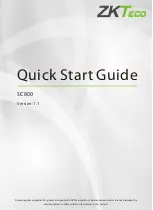
©
National Instruments Corporation
9
NI 9219 Calibration Procedure
2.
Set the source to the appropriate test point value indicated in Table 7. Use the smallest available
range needed to source each test point. Using a range larger than necessary creates unwanted
additional noise.
3.
Configure the DMM for a voltage measurement in the lowest appropriate range according to the
test point from Table 7.
4.
Enable Auto Zero on the DMM.
5.
Acquire a voltage reading with the DMM. Record the measurement as V
ref
.
6.
Create an AI thermocouple channel on the NI 9219. Configure the channel according to Table 6.
7.
Acquire 20 unscaled I32 readings with the NI 9219. Record the average of the readings as
data
unscaled
.
8.
Scale the data by using the formula below to change the unscaled data into volts.
where
range
max
is the maximum value (mV) in Table 7.
9.
Perform the following calculation using the recorded V
ref
and V
channel
values.
10. Compare the calculation result to the Upper Limit and Lower Limit values in Table 7.
11. Set the source output to zero and clear the acquisition.
12. Repeat steps 2 through 11 for all test points and all channels on the NI 9219. NI recommends that
you verify the values for all the iterations listed in Table 7 for each channel, but you can save time
by verifying only the values and channels used in your application.
13. Disconnect the source and the DMM from the device.
Table 6.
NI 9219 Configuration for Thermocouple Accuracy Verification
Measurement Type
Min (°C)
Max (°C)
ADC Timing Mode
Sample Timing Type
Thermocouple
0
100
High Resolution
On Demand
Table 7.
NI 9219 Verification Test Limits for Thermocouple Accuracy
Range
Test Point
1
–
Year Limits
Minimum (mV)
Maximum (mV)
Location
Value (V)
Lower Limit (V)
Upper Limit (V)
–125
125
Max
0.10
–0.000041
0.000041
Min
0.00
–0.000010
0.000010
V
channel
data
unscaled
2
23
-----------------------------
range
max
=
Accuracy
V
channel
V
ref
–
=










































